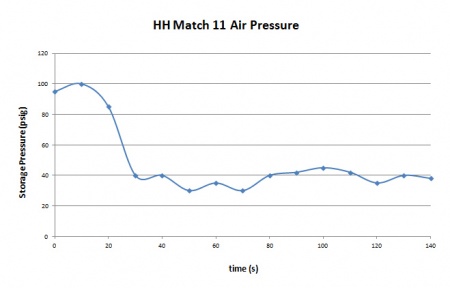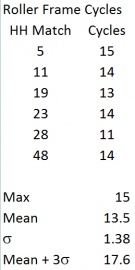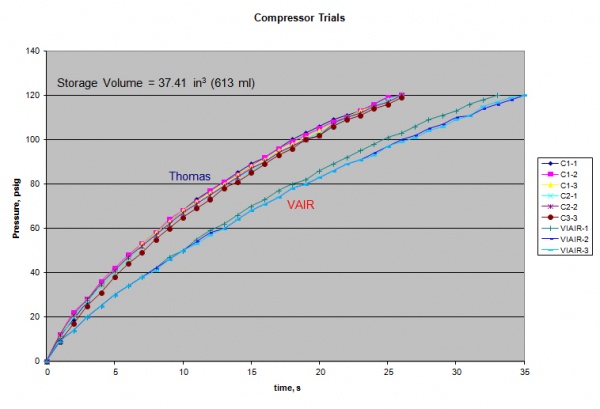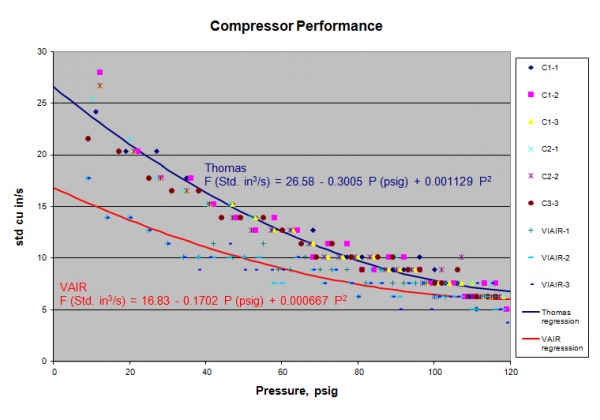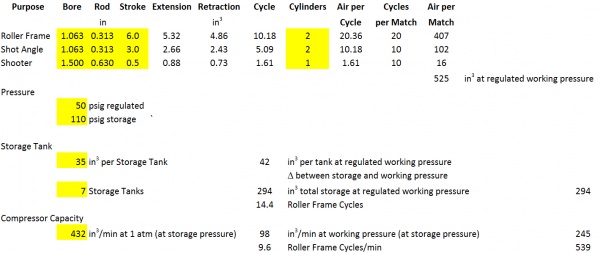DEWBOT X Hatboro-Horsham Shooter Failure
- Modifying shooter code to extend the fire period
- Adding a third and then a fourth air storage tank
- Replacing the shooter solenoid
During match 11, a GoPro camera was set up to watch the pressure gauges. This video shows that the pneumatic system lost pressure at an extraordinary rate during the first 20 seconds of teleoperated play, consuming the entire storage reserve (two 35 in3 tanks at the time) during those 20 seconds. Thereafter, both storage and regulated pressure were identical, ranging between 30 and 45 psig. This pressure is too low for the shooter cylinder to retract the winch's dog gear. The compressor never turned off during the match.
So the proximate cause of the shooter failure was low air pressure.
Contents
Air Demand
There are three users of compressed air, the Roller Frame, Shot Angle and Shooter. Air requirements for each of these are:
The Roller Frame is the big air user, requiring over 20 in3 of air (at regulated working pressure) for each cycle. The Roller Frame is also the most frequently deployed air user on the robot. Data from Hatboro-Horsham match videos reveal that the Roller Frame may be deployed up to 15 times in a match. The Roller Frame is also a very useful and versatile device, not something we want to curtail the use of.
Proposed Specifications
Starting with the Hatboro-Horsham frequencies, and assuming that this will increase as the season progresses, a proposal pneumatic specification should allow proper robot function (ability to fire the shooter) during matches having up to:
- 20 cycles of Roller Frame actuation
- 10 cycles of Shot Angle actuation
- 10 cycles of Shooter actuation
Leading to the following compressed air requirements:
Air Storage
DEWBOT X started H-H with two (2) 35 in3 Clippard air storage tanks and finished the competition with four (4) such tanks. The amount of utilizable air stored in these tanks depends upon the difference between storage and working (regulated) pressures. The exact relationship is:
So, if working pressure is 60 psig and initial storage pressure is 110 psig, then four (4) 35 in3 air storage tanks (V0 = 140 in3) contain a utilizable air volume, or working volume (Vw) of 117 in3 (at working pressure). This is enough air for 5.7 cycles of the Roller Frame. Note that the working volume increases of the working pressure decreases.
Compressors
DEWBOT X was equipped with a VAIR 0090 (a.k.a. VAIR 90C, am-2005) Kit of Parts compressor at Hatboro Horsham, with a nominal capacity of 0.88 scfm. If this were the actual feed rate, we would not have had an air problem at H-H.
The team also has a number of Thomas 405ADC38_12 compressors (from the 2010 & earlier Kit of Parts).
The Thomas compressor is considerably larger and heavier than the VAIR. Unlike the VAIR, the Thomas is rated for continuous use. It is also considerably more expensive (~$350) and as a not-a-kit-of-parts compressor must have its value included in-full in the BoM. This year, we can afford the weight and the BoM cost if the performance warrants it.
Compressor Trials
We measured actual performance of two (2) Thomas and one (1) VAIR compressor (from Deux).
Experimental
A plastic SMC storage tank having ¼” NPTF ports at both ends was plugged at one end with a brass plug. A second brass plug was prepared with Teflon tape but not inserted. The SMC storage tank with both brass plugs was weighed (321 g). The tank was then filled with tap water, sealed with the 2nd brass plug, dried and reweighed (933 g). The difference (612 g) indicates a tank volume (assuming 20°C water) of 613 ml (37.41 in3).
The brass plugs were removed and water thoroughly drained from the SMC storage tank. A pressure gauge was threaded into one end of the tank (using a ¼" x ⅛" brass NPT bushing) and a ¼" x ¼" Male Connector into the other end of the tank. A short length of ¼" tubing connects the Male Connector to a tubing tee. The tubing tee also connects (via short runs of ¼" tubing and via Male Connectors) to a manual vent valve via the branch and to the test compressor via the street connection.
A GoPro® Hero3 Black camera is set to record the pressure gauge at approximately the minimum focus distance. Recording was 1080 60P. For each test, the vent valve is closed, the GoPro is started and the compressor is turned on, in that sequence. There is no pressure switch in the circuit (but there is a pressure relief valve). The compressor is shut down manually upon reaching 120 psig on the gauge. Three compressors were tested: (2) Thomas and (1) VAIR. Each compressor was tested three times.
Analysis
Analysis was performed from the GoPro video footage. Each clip was loaded into Adobe Premiere Elements 11 and: 1) zoomed in to view the gauge; and 2) trimmed so that the start of the analyzed clip was moment when the compressor turned on. The footage was viewed on a frame-by-frame basis with pressure recorded every second. Pressure was recorded with 1 psi precision.
The Thomas compressors were observed to reach 120 psig faster than the VAIR compressor.
Calculation
Pressures from each trial were first converted to standard absolute air volumes (std in3), assuming isothermal compression. Supporting the isothermal assumption was: 1) no temperature increase was noted on the tank exterior surface (by touch); and 2) the system is small and uninsulated, facilitating rapid loss of compression heat. Excluding terminal points (0 & 120 psig), the derivative of standard volume in relation to time (dV/dt, std in3/s) was determined numerically.
Standard conditions are 1 atm (14.696 psia) and 20°C.
Finally, the dV/dt values were regressed versus P (psig) and P2. All Thomas compressor data was regressed as a single data set (150 observations; r2 = 0.95); all VAIR compressor data was likewise regressed as a data set (100 observations; r2 = 0.87).
Conclusions
The Thomas outperforms the VAIR compressor at all storage pressures, although the two converge at high pressure.
Meeting Specs
With the working pressure set to 50 psig, the Thomas compressor with (7) storage tanks meets the proposed pneumatics specifications.
The above analysis is conservative in that it uses the Thomas compressor performance at 110 psig.
Pressure Switches
The drive team observed that the pressure switch shut down the compressor at an unusually low pressure, well below 120 psig. The pressure switch used is not adjustable.We tested five (5) pressure switches in team inventory, labeled A-E, for cut-off pressure.
We will use switch "D" to replace the current pressure switch.
Conclusions & Actions
The shooter failure at Hatboro-Horsham was the result of the pneumatic system being incapable to meet the needs of Aerial Assist as it is played in competition. This problem is not observed on the practice field because practice is far more controlled and calm. In particular, the Roller Frame is not extended as frequently in practice as in competition.
Gary Deaver brings up the point that the higher winch forces used at Hatboro-Horsham would have also increased the force needed to withdraw the dog gear, and this is correct. Winch force and minimum dog gear release force would be expected to be proportional.
The pneumatic system will be upgraded to meet the competition needs by replacing the VAIR compressor with the Thomas and bringing the number of storage tanks to no fewer than 7. Pressure switch "D" will replace the current switch.
While pneumatic system leaks are a serious problem and we must continue to plug these leaks, the leaks were not a significant factor in the shooter problems experienced at Hatboro-Horsham.
The drive team has requested that the low-angle shot become the default. This change will be made.
The drive team also has the opinion (supported by video observation), that the "hold-to-extend" nature of the Roller Frame human interface contributes to more frequent, unnecessary deployment of the Roller Frame and have asked that this be changed to a "Push-to-deploy / Push-to-retract" interface.
